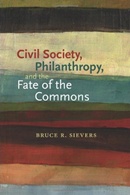 Bruce Sievers has written a very readable and interesting book on the concept of civil society, its history, and the problems it faces today. Its strength lies in its compactness, enabling everybody who considers themselves part of civil society (which should be everybody!) to get a clear picture of what it is, where it came from and where it might be going.
Bruce Sievers has written a very readable and interesting book on the concept of civil society, its history, and the problems it faces today. Its strength lies in its compactness, enabling everybody who considers themselves part of civil society (which should be everybody!) to get a clear picture of what it is, where it came from and where it might be going.
Sievers starts by explaining what civil society is. His definition – based on the work of many – revolves around the necessary presence of seven ‘key concepts’, namely philanthropy, the common good, the rule of law, non-profit and voluntary institutions, individual rights, free expression and tolerance. If these seven concepts are all present, one can conclude that a civil society exists. The occurrence of (forms of) philanthropy and a few of the other concepts in the Classical period and in the Middle Ages does not justify the assumption that a civil society existed then.
It is not until the Dutch Golden Age that all the necessary concepts can be detected in one single place. Sievers points to the writings of Justus Lipsius, Hugo Grotius and Benedict Spinoza as laying the foundations of the concepts of the rule of law, individual rights, free expression and tolerance in the Dutch Republic.
In Sievers’ words, Spinoza sees liberty as the true aim of government. The state and the individual can harmoniously coexist only if both are guided by a norm of toleration and a maximum degree of free expression. This will then result in the acceptance of the rule of law and the creation of individual rights, for which the foundations have been laid in the work of Grotius.
Not only did the theoretical framework come from the Netherlands, but the actual presence of a civil society could be identified in the Dutch Golden Age. Charitable giving, municipal orphanages, multiple forms of civil association, even lotteries to collect money for the poor (which run until this day) were all part of the day-to-day life of the Republic.
Through Dutch-Englishman John Locke and English-Dutchman Bernard Mandeville, but in practice especially through stadtholder/king William III, the ideas forming the basis of civil society in the Netherlands are brought to the United Kingdom at the end of the seventeenth century. From there it is further developed by the great minds of the Scottish Enlightenment like Adam Smith, David Hume and Adam Ferguson (who wrote his own ‘Essay on the History of Civil Society’ in 1767). All seem to struggle with the tension between individual self-seeking behaviour and the advancement of the well-being of society.
The historic tour of civil society ends in the USA. Here the First Amendment to the Constitution is introduced as a nearly intentional designed charter for civil society, and we meet the great philanthropists of the 19th century and their new ‘scientific’ philanthropy, which – in different forms – is still present today.
After this short but interesting account of the development of civil society in the Western world, Sievers gets us where he seemingly wants us to be: at the core of the present-day debate on civil society and the best way to secure its future role and the fate of the commons. It is in the final chapter that he puts forward his own ideas on the present state of civil society. Here the downside of such a concise work is apparent as Sievers gives himself limited room to set out his intriguing views.
Certain things Sievers puts forward merit a good discussion. For instance, one of the roles he sees for present-day philanthropy is to strengthen civil society. He seems here to be encouraging a strategic philanthropic approach, which he criticizes elsewhere in his book. Strategic philanthropy helps by looking into the core reasons why certain social problems exist in order to be better able to solve them. In another instance, the author suggests that philanthropy should bail out major newspapers when they are not sustainable on their own. This does not seem to be an effective way to build the civic function of the media.
Most intriguing is Sievers’ non-acceptance of the influence of a number of business-related concepts – in the sphere of accountability and impact – on the non-profit and philanthropic sector. Of course, the special situation has to be taken into account and civil society is not equal to the marketplace, but under comparable conditions all pigs (without wings) can be treated and assessed equally.
The interesting thing here is that the same market that Sievers wants to keep separate from civil society was the main driver for enabling the Western world’s first civil society to emerge in the Dutch Republic in the 16th and 17th centuries.
Charles Erkelens is executive director of the Erasmus Centre for Strategic Philanthropy at Rotterdam University. Email erkelens@ese.eur.nl
Civil Society, Philanthropy, and the Fate of the Commons
Bruce R Sievers Tufts University Press $29.95
ISBN 9781584658955
To order
http://www.upne.com






Comments (0)